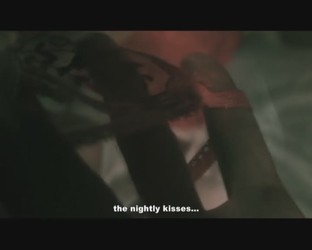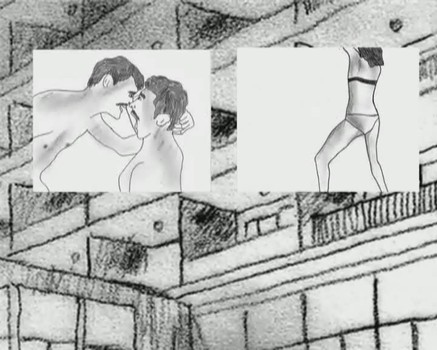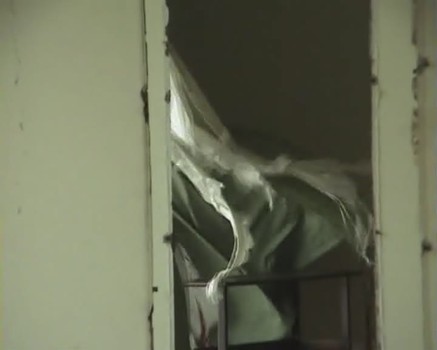
Colorful lingerie and risqué poetry describe the frustration of a sexually dissatisfied Iranian woman in a video called Every Night Three Kisses by artist Negar Behbahani. "When everything is over in the first twelve seconds, every night this confounded countdown," says the protagonist.
Behbahani, who is from Iran, had to audition 20 women before finding someone to play a woman who suppresses her desires night after night. Female actors feared jeopardizing their careers. They did not want to risk the ire of the public or the authorities.
The 28-year-old artist was also afraid of the consequences. But this is her portrayal of Iranian women placing men's sexual needs above their own and eventually surrendering into a relationship of toleration. "Our generation claim to be different from our mothers on this matter, but sometimes I think there is a very long path ahead of us," she says. "Our sacrifice become limitless and we change ourselves for a man we love till we become strangers for ourselves."
The video is currently part of an art exhibition, "Antinormanybody," which is showing till August 10 at the Kleio Projects Gallery in New York, run by Christine O'Heron. The gallery is the size of a small room on a quiet street in Lower Manhattan. It features the work of upcoming artists from the Middle East and North Africa.
This exhibition showcases experimental films that portray the human body in ways that challenge the stereotypes coupled with the region. "There is no veiled woman," says Barrak Alzaid, the artistic director of ArteEast, a New York-based non-profit that supports artists from the Middle East. "This is about what Arab, Middle Eastern bodies are and what they can do."
Some viewers find the woman in Behbahani's video to be the more powerful partner. She is, after all, the more passionate figure who dominates the story, while the man fades into the background.
Others, however, see her as trapped as the flowers in her netted lingerie. "I am the soul of nightly kisses in the folds of bed sheets," she says in the video. "And you, how prematurely spoiled the joy of my flow."
(Still from the video)
In the final scene, the woman is seen sowing her own skin with a needle and thread. "She is stitching into herself her dissatisfaction, desperation and disillusionment and they all remain inside her forever," says Behbahani.
Another video in the exhibition addresses a different sort of silence -- a communal suppression of ideas and events that make society uncomfortable.
In a video called "I've heard stories," Marwa Arsanios, a Lebanese artist, explores homosexuality and censorship in her country. The piece is a fresh investigation into a two-decade-old murder at the Carlton hotel in Beirut.
Arsanios was 15-years-old when Henri Pharon, an icon of the Lebanese freedom struggle against France, was murdered by his former driver in 1993. He had designed the country's flag, collected valuable art and was one of the richest men in the country.
While his murder was a national story, Arsanios recalled that nobody said anything about the victim being gay, which, according to the artist, was widely known at the time.
"Even my parents were talking about the crime but without saying that he was gay and that the reason was a crazy affair he was having with his driver," she says.
Pharon, 92 at the time of his death, was brutally stabbed by a former driver. His new driver was also found stabbed to death in the same room. The official account said that money, which had been stolen from the room, was the motivation for the crime.
Arsanios, who pored over newspaper clippings of the case, offers an alternate history through fictional characters in her animated sketch. There is Nora, a stripper, who witnesses the murder and there is a gay couple in a hotel room.
(Still from the video)
Persian erotic miniature drawings served as an inspiration for the artist. "It is interesting for me to show how this practice was represented in the 16th century and totally censored out of all discourses in modern times," she says.
A few bars of "What is love, Baby don't hurt me, no more" play abruptly in the five minute video. The black-and-white images are interrupted by a girl dancing in the ruins of the hotel, who symbolizes both a break and continuity between the past and present.
This unofficial version of the events is offered to the public as a stab at the truth, twenty years later. The artist intends to present an alternate history of two other murders. "In a country were you don't trust the state or the tribunal and the official announcements, you need to investigate for yourself," she says.
Besides the murder mystery, the video is also a story of a changing city. The Carlton hotel was built by Karol Schayer, a Polish architect, who came to Beirut during Second World War and he is credited with modernizing the city.
A centerpiece of the city for decades, the hotel closed some years after Pharon's murder. When it was being cleared in 2008, Arsanios went to the hotel to buy some of its furniture and curtains.
(Still from the video)
The scene of the crime on the eighth floor, ignited past memories. The artist has stitched some of the hotel's curtains into clothes for herself so that old secrets can live on.



